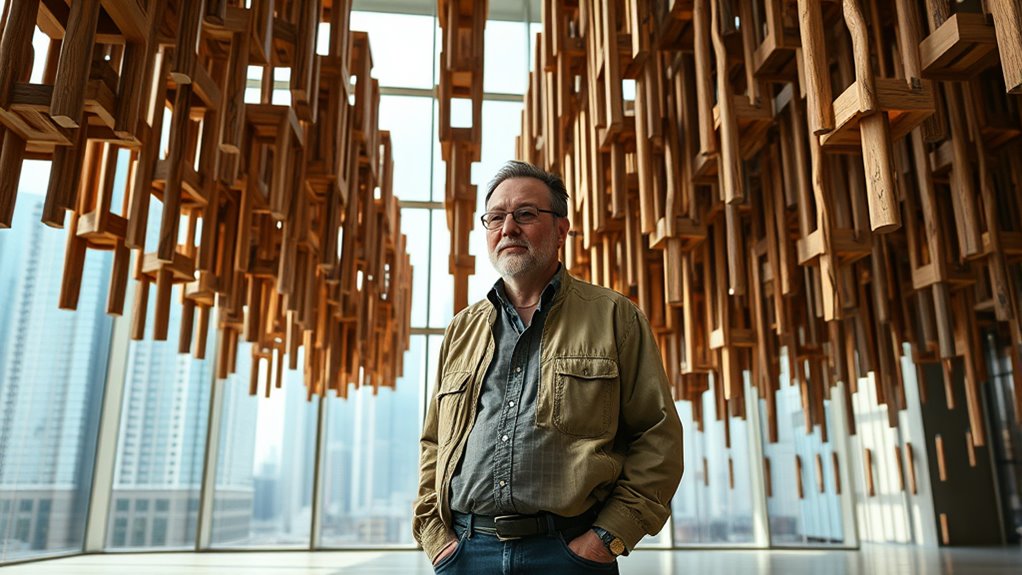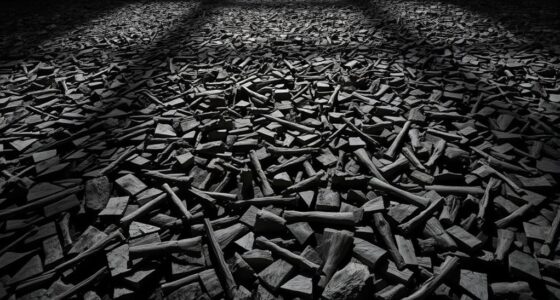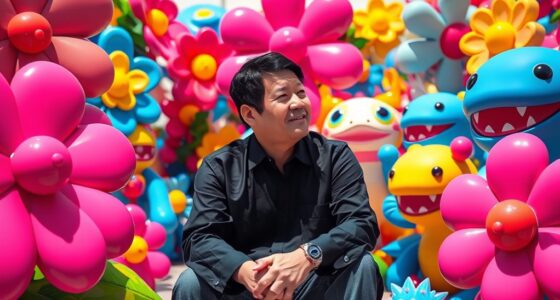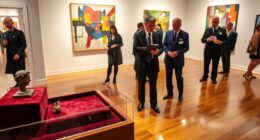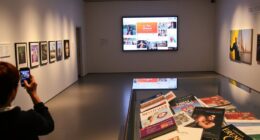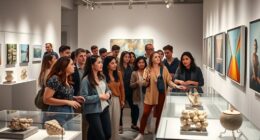Ai Weiwei uses art to challenge China’s traditions and push for social change. His work combines sculpture, installation, and activism to spotlight human rights issues and censorship. As a prominent global voice, he promotes cross-cultural dialogue, blending Chinese heritage with contemporary ideas. His fearless approach inspires future generations to confront societal norms. To see how his influence shapes China’s voice on the world stage, explore more about his groundbreaking projects and activism efforts.
Key Takeaways
- Ai Weiwei merges traditional Chinese elements with contemporary art to challenge cultural norms and address social justice issues globally.
- His provocative works, like “Sunflower Seeds” and “Dropping a Han Dynasty Urn,” question cultural heritage and artistic authority.
- Ai Weiwei employs social media and digital activism to highlight human rights abuses and challenge censorship in China.
- Through international collaborations and exhibitions, he promotes cross-cultural dialogue and enhances China’s global cultural influence.
- His activism and innovative art inspire future generations to advocate for freedom, transparency, and societal change worldwide.
Early Life and Cultural Roots
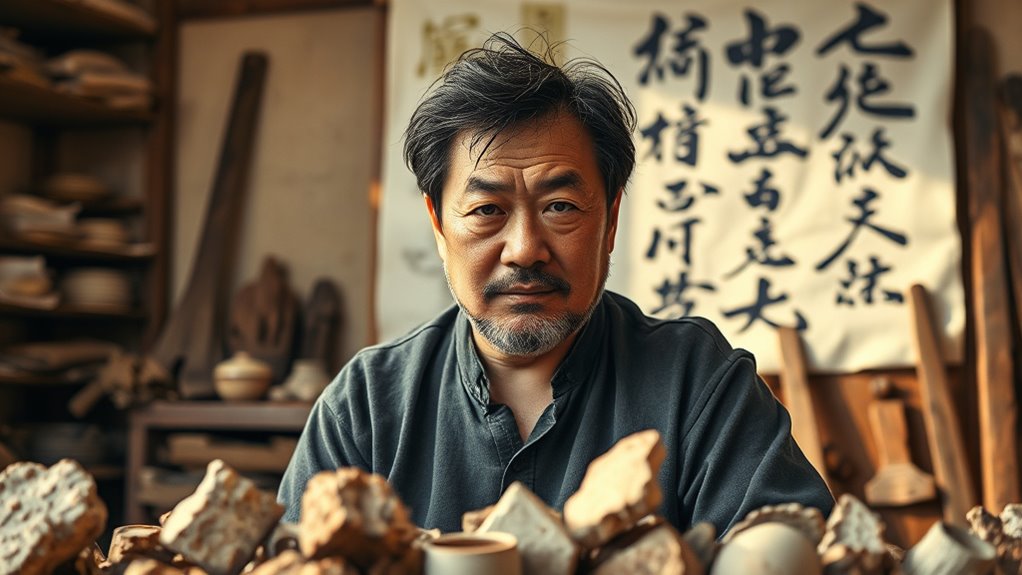
Born in Beijing in 1957, Ai Weiwei grew up amid the upheavals of China’s tumultuous history. His father, Ai Qing, was a renowned poet, shaping Ai Weiwei’s cultural and intellectual foundation. When his family was labeled as “rightists,” they faced exile, living in harsh conditions in Heilongjiang and Xinjiang. These experiences exposed him to remote, challenging environments and deepened his understanding of cultural resilience. His childhood experiences in exile fostered a sense of perseverance that would later influence his artistic and activist pursuits. After Mao’s death, the family returned to Beijing in 1976, and Ai Qing was rehabilitated, allowing Ai Weiwei to reconnect with his roots. Growing up amid political turmoil and intellectual influences, he inherited a legacy that would later inform his activism and art. His early life instilled resilience and a profound awareness of cultural heritage. His childhood experiences in exile also contributed to his later commitment to social justice and human rights, highlighting the importance of cultural resilience. Additionally, these formative years helped cultivate his emotional resilience, enabling him to face contemporary social challenges with strength and conviction. Furthermore, the exposure to diverse environments in his youth helped develop a global perspective that influences his international activism today. Moreover, these hardships emphasized the significance of cultural perseverance in overcoming adversity and shaping identity.
Artistic Evolution and Key Influences

Ai Weiwei’s artistic journey shifted from traditional painting to more conceptual and media-driven work as he sought new ways to express his ideas. You see, he initially focused on painting before exploring sculpture, inspired by Marcel Duchamp’s readymades. During the 1990s, he co-published avant-garde art books outside official channels, promoting China’s underground art scene. His profile grew with the 2000 “Fuck Off” exhibition, challenging norms. He built a personal studio in Beijing’s outskirts in 1999, emphasizing simplicity and using common materials. In 2003, he founded FAKE design studio, blending architecture with conceptual art. Projects like “Fairytale” (2007) and “Sunflower Seeds” (2009–2011) expanded his social commentary, while digital platforms from 2005 onward amplified his activism and global influence. Additionally, his work exemplifies how artistic evolution can serve as a form of activism and social critique, demonstrating how methodical approaches in art can effectively communicate complex messages. His engagement with community support features has also helped foster a global dialogue on human rights and freedom of expression. Furthermore, his contributions highlight the significant role of global influence in shaping contemporary art and activism. Recognizing the importance of artistic experimentation, Ai Weiwei continually pushes boundaries to challenge societal and political norms.
Challenging Traditions Through Multi-Disciplinary Art
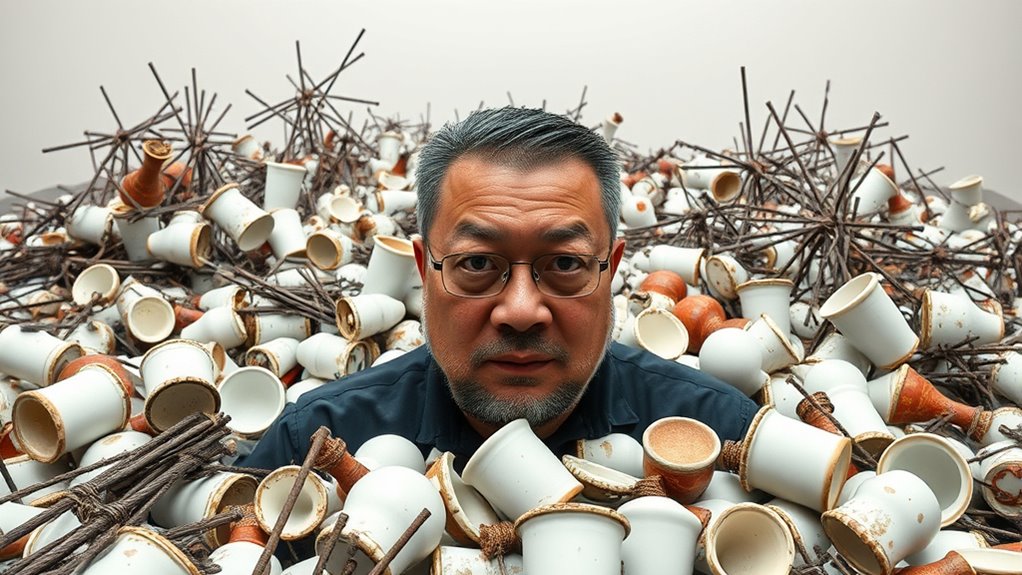
By integrating multiple artistic disciplines, Ai Weiwei challenges traditional notions of art and cultural norms. He combines sculpture, filmmaking, photography, ceramics, painting, and writing to push boundaries and provoke thought. Using traditional Chinese elements, he addresses cultural identity and social issues, blending craftsmanship with contemporary concepts. His projects often transform everyday objects into powerful statements—painting, grinding, or slapping logos onto artifacts—questioning their value and significance. Ai Weiwei also creates large-scale installations and monumental sculptures, emphasizing social commentary through labor-intensive works. He engages communities beyond gallery spaces by collaborating on projects that tackle real-world problems. His innovative approach merges traditional influences with modern design principles, creating visually stunning, conceptually rich art that challenges and expands cultural and societal norms. Additionally, his multi-disciplinary practice exemplifies how diverse mediums can be integrated to amplify social and political messages, making his work accessible and impactful across different audiences. This approach demonstrates how artistic diversity can serve as a powerful tool for activism and cultural dialogue. Incorporating cultural elements from his Chinese heritage, Ai Weiwei enriches his work with deeper historical and social context, further strengthening his messages. Furthermore, employing dynamic communication techniques, he fosters a deeper connection with viewers, encouraging active engagement with his messages. Moreover, understanding the importance of space and organization in his installations, Ai Weiwei carefully considers how viewers navigate and experience his works to maximize their impact.
Pushing Boundaries: Activism and Political Engagement
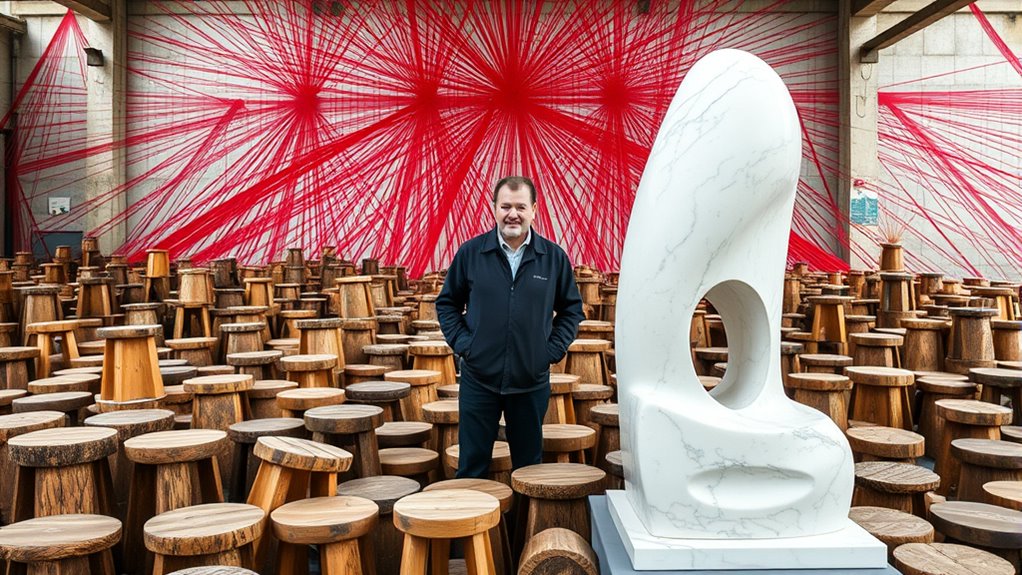
Ai Weiwei transforms art into a powerful tool for activism and political engagement, using his work to highlight issues like human rights violations and the struggle for free speech. He leverages social media platforms such as Weibo, Twitter, and Instagram to amplify his voice, mobilize public opinion, and criticize authoritarianism worldwide. His activism includes exposing government corruption, particularly criticizing the 2008 Sichuan earthquake schoolhouse failures and publishing victims’ names to demand accountability. Ai also engages in international projects, like the Bird’s Nest stadium, to challenge state propaganda and promote global dialogue on social justice. His art serves as a form of dissent, inspiring audiences and fostering awareness of social injustices. Additionally, his efforts extend to preventing destructive behavior, utilizing innovative methods to ensure his activism remains impactful and enduring. He employs digital activism strategies to reach a broader, global audience and sustain pressure for change. Through these efforts, he pushes boundaries and uses his platform for meaningful political and social change. Cookies are often used to track online activity related to his campaigns, helping to gauge public interest and engagement. Furthermore, Ai Weiwei emphasizes the importance of vetted information to ensure his messages are credible and effectively support social movements. Reliable and factual data underpin his work, strengthening the foundation of his activism. Recognizing the importance of raw data in shaping effective activism, he often collaborates with researchers and journalists to base his work on factual evidence.
Iconic Works and International Acclaim
Among his most celebrated works, “Sunflower Seeds” stands out as a striking example of Ai Weiwei’s ability to merge craftsmanship with social commentary. This 2010 installation features 100 million porcelain sunflower seeds, each handcrafted, symbolizing China’s mass production and uniformity. Ai Weiwei’s “Dropping a Han Dynasty Urn” challenges traditional notions of art and cultural heritage through a provocative triptych. His “Forever Bicycles” series highlights societal dynamism with interconnected bicycles, inspired by Marcel Duchamp. Ai Weiwei’s “Circle of Animals/Zodiac Heads” explores cultural loss and revival. His “Map of China” reflects on geography and identity. Understanding regional legal resources can enhance the effectiveness of advocacy and art in social activism. Additionally, his engagement with cultural preservation underscores the importance of protecting intangible aspects of heritage amidst rapid modernization. Incorporating artistic techniques from traditional Chinese craftsmanship can further deepen the cultural impact of his work.
Ai Weiwei’s “Sunflower Seeds” exemplifies craftsmanship intertwined with social commentary and cultural critique.
- Exhibition at Tate Modern drew tens of thousands, boosting his global recognition
- His works are in major museum collections worldwide
- His art sparks discussions on culture, politics, and social change
Shaping China’s Cultural Dialogue on the Global Stage
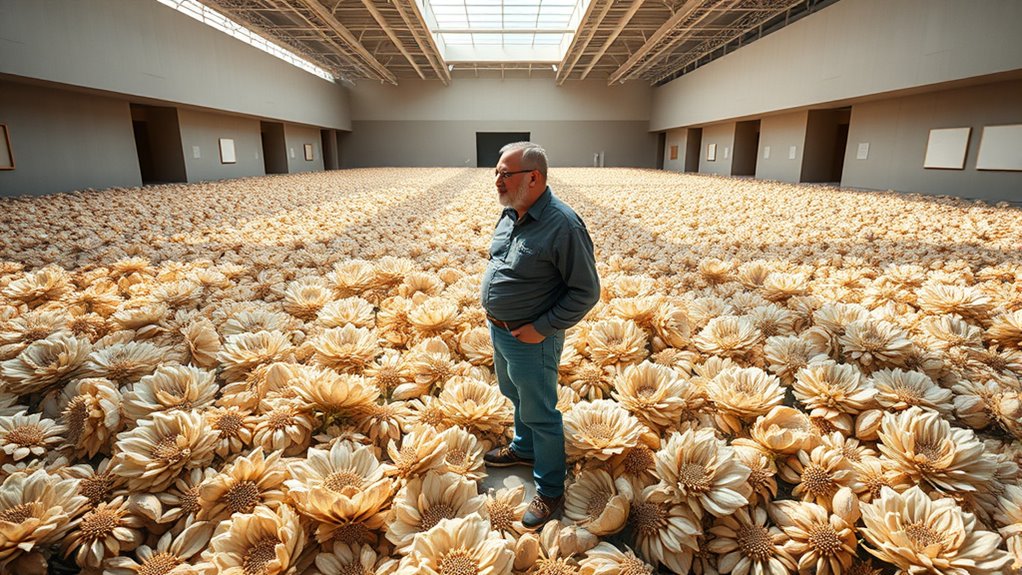
You play a crucial role in understanding how Ai Weiwei uses his art to shape China’s cultural dialogue globally. His work challenges censorship norms and promotes cross-cultural exchanges, fostering mutual understanding. By doing so, he transforms art into a powerful tool for diplomacy and societal change.
Cultural Diplomacy Through Art
How does art serve as a powerful tool for China’s cultural diplomacy on the global stage? Your engagement with Ai Weiwei’s work reveals how his art blends contemporary Chinese culture with global themes, shaping perceptions worldwide. His participation in major international exhibitions elevates China’s presence in the arts. Through cross-cultural themes like human rights and freedom of expression, his works foster meaningful dialogue. Collaborations with international artists and organizations further promote cultural exchange, broadening understanding of Chinese perspectives. Symbols from Chinese tradition are reinterpreted in a global context, sparking conversations beyond borders. This strategic use of art enhances China’s soft power, demonstrating its cultural influence and encouraging international audiences to connect with Chinese narratives on justice, identity, and innovation.
- International exhibitions boost China’s global art presence
- Cross-cultural themes foster global dialogue
- Collaborations promote cultural understanding
Challenging Censorship Norms
Censorship in China substantially shapes its cultural dialogue by restricting creative expression and controlling the narratives artists can explore. The government prioritizes political stability over freedom of speech, limiting open dialogue in art and literature. Ai Weiwei describes censorship as “suffocating,” likening it to a lack of fresh air that stifles innovation. Restrictions on language prevent writers and artists from fully exploring their thoughts and emotions. To maintain its authority, the Chinese Communist Party strictly controls cultural output, silencing dissent and homogenizing narratives that favor the official ideology. Ai Weiwei actively challenges these norms by using his art to confront censorship, spotlight human rights issues, and amplify suppressed voices. His work pushes boundaries, inspiring global conversations about artistic freedom and the importance of resisting oppressive controls.
Fostering Cross-Cultural Dialogue
Ai Weiwei actively fosters cross-cultural dialogue by leveraging diverse art forms such as sculpture, installation, and photography to connect audiences worldwide. His projects like “Fairytale” and Documenta 12 create platforms where Chinese participants and international viewers exchange ideas, experiences, and cultural perspectives. Through collaborations with artists and architects, he emphasizes transparency and openness, encouraging dialogue across borders. Translation plays a crucial role, helping to bridge language gaps and deepen understanding among different cultures. These efforts shape China’s cultural presence globally, promoting human rights and mutual respect. By engaging audiences in participatory art and utilizing technology, Ai Weiwei facilitates meaningful conversations that transcend national boundaries.
- Art projects connecting Chinese and global audiences
- International exhibitions fostering cultural exchange
- Collaborations emphasizing transparency and openness
Legacy and Impact on Future Generations
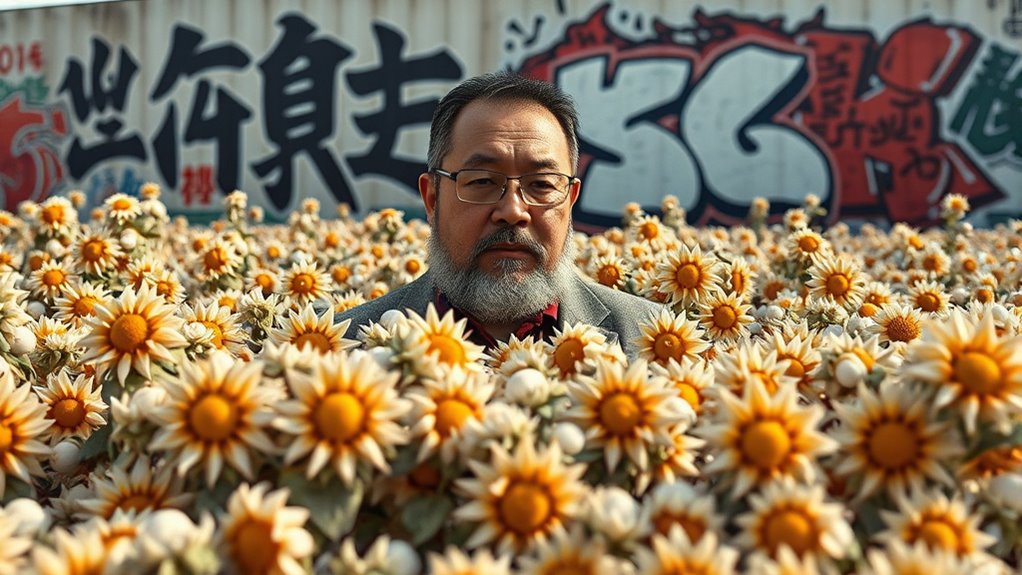
Your future as an artist or activist will likely be influenced by Ai Weiwei’s example of courageous expression. His innovative approach encourages you to challenge norms and advocate for social change through your work. By inspiring new generations, Ai Weiwei’s legacy shapes ongoing cultural conversations and activism worldwide.
Inspiring Artistic Activism
How does an artist’s bold use of diverse media inspire future generations to challenge societal norms and advocate for justice? Ai Weiwei’s work demonstrates that art can be a powerful tool for activism across multiple platforms. His sculptural installations spotlight political issues like human rights abuses, encouraging viewers to question authority. His photography and films expand his message, making social issues more accessible. Architectural projects like the Bird’s Nest Stadium show how art can merge with functionality to symbolize societal values. Additionally, using digital platforms amplifies his voice globally, inspiring young artists to harness social media for activism. His manipulation of cultural artifacts bridges tradition and modernity, urging future artists to push boundaries and stand for justice through innovative, impactful art.
- Inspires new artists to address social issues through diverse media
- Demonstrates the power of digital activism in modern society
- Merges tradition with contemporary activism to challenge norms
Shaping Cultural Discourse
Ai Weiwei’s innovative approach to art not only pushes creative boundaries but also shapes the ongoing dialogue about China’s cultural identity and societal values. You see, his work critiques China’s cultural heritage and modernization, influencing how future generations perceive cultural change. By encouraging critical thinking about traditions, he fosters a nuanced cultural discourse. Using salvaged materials, he preserves Beijing’s past amid rapid urban growth, emphasizing the importance of cultural preservation. His global recognition sparks international conversations on human rights and cultural identity, inspiring future artists to challenge authority and explore social issues. Ai Weiwei’s legacy encourages innovation, cultural engagement, and activism, shaping how upcoming generations understand their history, identity, and the role of art in societal transformation.
Frequently Asked Questions
How Has Ai Weiwei’s Political Activism Influenced His Artistic Career?
Your question highlights how Ai Weiwei’s activism shaped his artistic journey. His outspoken criticism of government policies and social issues fueled his creative work, making it more political and provocative. Repression and surveillance pushed him to use international platforms, spreading his messages globally. His art became a tool for documenting injustice, challenging censorship, and advocating for human rights, ultimately elevating his work from national to worldwide prominence.
What Challenges Has Ai Weiwei Faced From the Chinese Government?
You face an unimaginable crackdown from the Chinese government. They arrest you at airports, detain you for months without charges, and revoke your passport, trapping you inside. Your studio gets demolished, and you’re constantly watched, harassed, and restricted from traveling or expressing yourself. Internet censorship and bans on your art and films make it nearly impossible to speak out. It’s a relentless battle to survive and create under an oppressive, watchful regime.
How Does Ai Weiwei Incorporate Traditional Chinese Culture Into Contemporary Art?
You see that Ai Weiwei incorporates traditional Chinese culture into his contemporary art by transforming artifacts like Han Dynasty urns and using traditional kite-making techniques. He manipulates cultural symbols, blending them with modern concepts to provoke thought and critique. His work highlights the materiality of tradition, while addressing cultural loss and political issues, creating a dialogue that resonates globally and challenges audiences to rethink cultural heritage in a contemporary context.
In What Ways Has Ai Weiwei Used Social Media to Promote Activism?
You might think social media is just for sharing photos, but Ai Weiwei proves it’s a powerful tool for activism. He uses VPNs to bypass censorship, posts political critiques, and mobilizes crowds online. By crowdsourcing investigations and sharing impactful visual stories, he raises awareness and challenges government repression. His digital presence sparks global conversations, influences policy debates, and inspires worldwide support for social justice, showcasing social media’s role in modern activism.
What Is Ai Weiwei’S Impact on International Perceptions of Chinese Art and Politics?
Your understanding of Ai Weiwei’s impact shows how he shapes international views of Chinese art and politics. Through global exhibitions like Tate Modern’s “Sunflower Seeds,” he highlights China’s societal issues and pushes boundaries. His activism challenges censorship and government control, making Chinese political struggles visible worldwide. By blending art with activism, you see how he redefines Chinese art’s role as a platform for resistance and global dialogue.
Conclusion
Imagine Ai Weiwei as a lighthouse, piercing through the fog of silence and tradition. His art and activism illuminate China’s complex landscape, guiding future generations toward truth and change. Just as a lighthouse stands firm against crashing waves, he confronts oppression with unwavering resolve, inspiring others to navigate the waters of cultural dialogue and social justice. His legacy beckons you to stand firm, shining your own light in the face of darkness.

